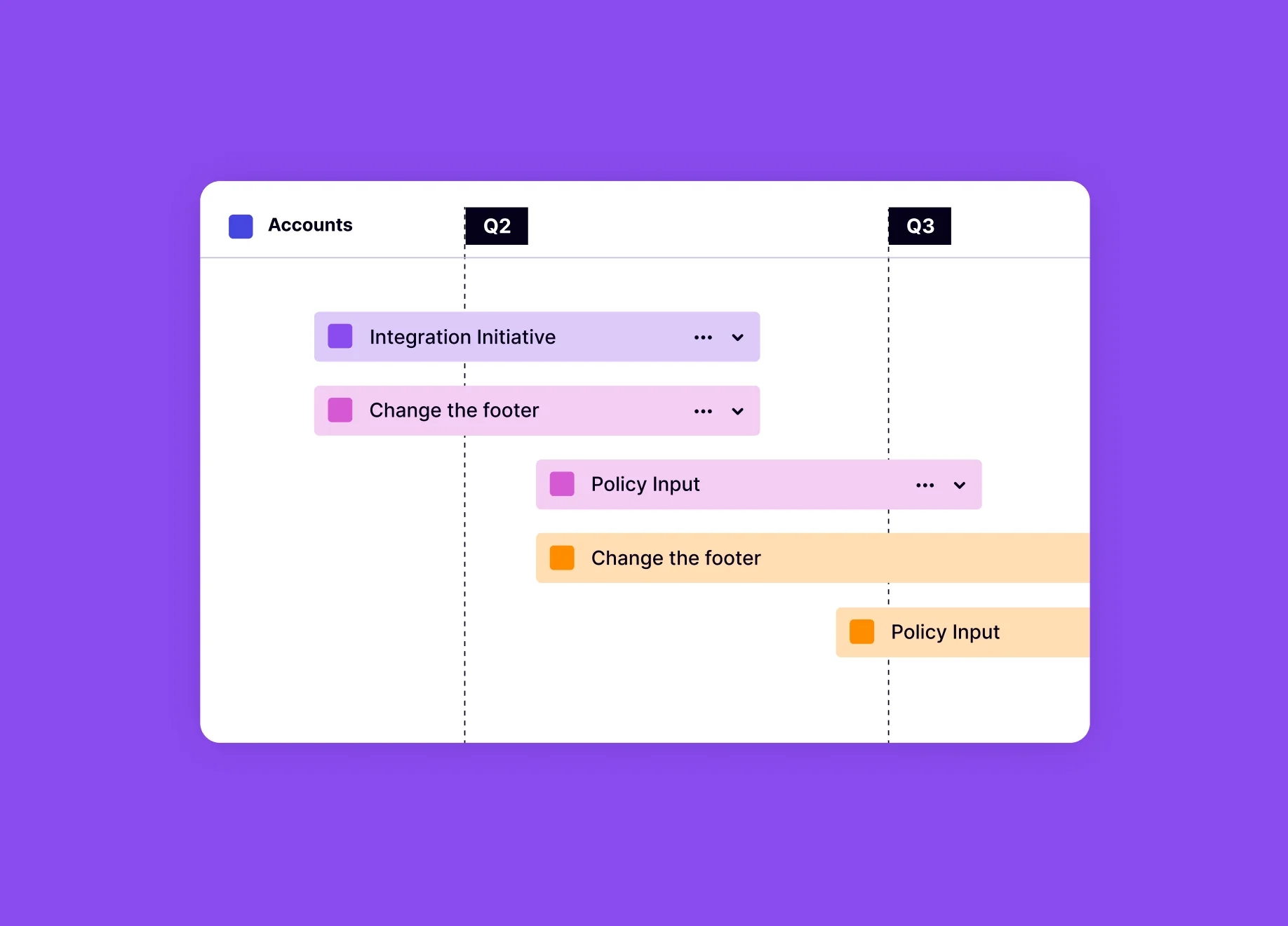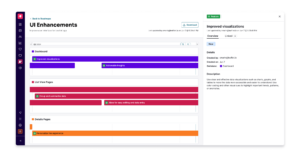
EIN UMFASSENDER LEITFADEN FÜR
Produkt-Roadmap
Eine visuelle Übersicht über den Fahrplan eines Produkts, um die Kommunikation mit bestehenden und potenziellen Kunden, Partnern und internen Stakeholdern zu erleichtern.
Tiefere Einblicke
Inhaltsverzeichnis
Was ist eine Produkt-Roadmap
Eine Produkt-Roadmap ist eine visuelle Übersicht über den Fahrplan eines Produkts. Mit seiner Hilfe wird die Kommunikation mit bestehenden und potenziellen Kunden, Partnern und internen Stakeholdern erleichtert.
Roadmaps skizzieren die beabsichtigte Richtung eines Produkts, seine wichtigsten Funktionen und künftigen Initiativen, die auf der Grundlage von Nutzerforschung und Stakeholder-Feedback entwickelt werden.
For product-led organizations, a product roadmap’s primary purpose is to define, communicate, and guide the direction that product development will take in the foreseeable future—facilitating the success of said development efforts to deliver on the expectations of all interested parties. Where digital transformation via software products is concerned, such roadmaps apply equally to software developed for internal use or sale to external consumers.
In den Dokumenten zur Produkt-Roadmap werden die Vision, die beabsichtigte Ausrichtung und die Prioritäten des Produkts im Laufe der Zeit dargestellt und festgelegt.
Mit einer Roadmap können Sie sicherstellen, dass sich alle Teams an den Produktzielen orientieren, die Pläne effektiv an die Beteiligten kommunizieren und die Funktionen priorisieren, von denen die Nutzenden am meisten profitieren. Letztlich fördert eine gut ausgearbeitete Produkt-Roadmap einen kooperativen und strategischen Ansatz bei der Produktentwicklung, was zu einem erfolgreicheren Ergebnis führt.
Wie wird eine Produkt-Roadmap verwendet?
Rather than a statement of commitment or a detailed “contract,” a product roadmap signals general product direction as currently intended and understood, yet it must be able to shift with changes in market and business conditions. In this spirit, product-led organizations should see a product roadmap as a living document, a snapshot in time that is subject to frequent change. The more distant the time horizon, the less reliable the commitments.
Zum Beispiel können Roadmap-Punkte, die drei Monate entfernt liegen, als relativ verpflichtend angesehen werden. Bei einem Sechs-, Neun- und Zwölfmonatshorizont sinkt zunehmend die Sicherheit. Ebenso nimmt mit zunehmendem Zeithorizont der Detaillierungsgrad der Roadmap ab. Für frühere Zeitpunkte (näher am jetzigen Zeitpunkt) bietet die Roadmap einen spezifischeren Überblick über Merkmale und Funktionen. Im Gegensatz dazu stellen spätere Zeitpunkte einen breiteren thematischen Überblick über das Kommende dar.
4 verbesserte Geschäftsergebnisse dank Pendo
Wie unterscheidet sich eine Produkt-Roadmap von einem Projektplan?
Zwar sind beide wichtige Werkzeuge in der Produktentwicklung, aber Produkt-Roadmaps und Projektpläne dienen unterschiedlichen Zwecken und sind unterschiedlich detailliert. Produkt-Roadmaps nehmen eine übergeordnete Perspektive ein und konzentrieren sich auf die Gesamtvision und die strategischen Themen des Produkts, anstatt sich in den Details zu verzetteln.
Produkt-Roadmap
Eine Produkt-Roadmap bietet einen Überblick über die Ausrichtung und die strategischen Themen des Produkts. Der Schwerpunkt liegt auf dem „Was“ und „Warum“ der zukünftigen Entwicklung und skizziert langfristige Ziele und Initiativen. Betrachten Sie sie als einen Kompass für die Product Journey.
- Focus: Vision and themes
- Detail: Broader
- Timeline: Long-term
- Audience: Wider – internal & external
Projektplan
Im Gegensatz dazu konzentriert sich ein Projektplan auf die spezifischen Details der Ausführung eines einzelnen Projekts innerhalb der Roadmap. Er definiert das „Wie“ der Erreichung eines bestimmten Ziels und umreißt die zur Fertigstellung erforderlichen Aufgaben, Zeitpläne, Ressourcen und Abhängigkeiten. Er ist wie ein detaillierter Stadtplan innerhalb des Landes, das die Roadmap darstellt.
- Focus: Task execution
- Detail: Highly detailed
- Timeline: Short-term for specific features
- Audience: Internal – project team
Obwohl Produkt-Roadmaps normalerweise nur einen groben Überblick bieten, können Sie die präsentierten Details an unterschiedliche Zielgruppen anpassen. So können Kunden und Kundinnen beispielsweise eine vereinfachte Roadmap mit der allgemeinen Vision sehen, während interne Teams vielleicht mehr Details benötigen.
Warum sind Produkt-Roadmaps für eine erfolgreiche Produktentwicklung unerlässlich?
Product roadmaps serve as a foundational element for successful product development. A well-defined roadmap provides strategic direction, ensures clear communication across teams, and promotes alignment around product goals—all critical for effective change management. A well-defined roadmap fosters a strategic approach to building a product that delivers value to users and achieves business objectives.
Strategic direction: Like a compass, product roadmaps define the product’s overall vision and establish a clear path for achieving long-term goals. This definition ensures everyone aligns on the product’s direction and working towards the same objectives (such as delivering an exceptional user experience).
Clear communication and collaboration: The roadmap acts as a central communication hub, fostering transparency and understanding across all teams. Everyone has a shared sense of product priorities, upcoming features, and timelines, eliminating confusion and promoting a collaborative approach to development.
Alignment around product goals: By visualizing features and initiatives on the roadmap, you can make informed decisions about what to build first. Using a prioritization framework will help you focus development on features that deliver the most value to users and the business while de-prioritizing less critical ones.
Was sind die wichtigsten Funktionen einer Produkt-Roadmap?
Betrachten Sie eine Produkt-Roadmap als einen Kompass für die Product Journey. Sie definiert die Gesamtvision des Produkts, skizziert die wichtigsten Funktionen und Initiativen und legt einen Zeitplan für die Entwicklung fest. Roadmaps erfüllen mehrere wichtige Funktionen:
Kommunikation
Eine Roadmap dient als zentrale Informationsquelle und erleichtert die klare Kommunikation zwischen den Teams (Produkt, Entwicklung, Marketing usw.), indem sie ein gemeinsames Verständnis für Folgendes schafft:
- Product vision: Everyone knows and can align on the long-term direction and goals of the product.
- Feature priorities: Teams understand which features are most important to focus on at different stages.
- Initiative timelines: Different departments can plan their work based on the roadmap’s timeline for upcoming features and initiatives.
Planung
Die Roadmap unterstützt Sie bei der Planung und Priorisierung von Funktionen auf der Grundlage strategischer Ziele und Benutzeranforderungen. Sie können die Roadmap beispielsweise für Folgendes verwenden:
- Align with business goals: Ensure features contribute to achieving the overall business objectives.
- Address user pain points: Prioritize features based on user feedback and data gathered through tools like Pendo Listen.
- Plan resources: Allocate resources effectively based on the roadmap’s prioritized features and timelines.
Prioritätensetzung
Durch die Visualisierung der Roadmap können Sie fundierte Entscheidungen darüber treffen, was zuerst erstellt werden sollte und was warten kann. So haben Sie folgende Möglichkeiten:
- Focus on high-impact features: Prioritize features that deliver the most value to users and the business.
- Manage dependencies: Identify dependencies between features and plan development accordingly.
- Adapt to change: Be flexible and adjust priorities to reflect market shifts or user expectations and feedback.
Wer verwendet Produkt-Roadmaps?
Product roadmaps are valuable tools for teams and stakeholders involved in the product development lifecycle both inside and outside the enterprise.
Product managers: Product managers rely on the roadmap to define the product vision, prioritize features based on user needs and strategic objectives, and communicate progress to internal and external stakeholders.
Developers: The roadmap provides insight into upcoming features and dependencies between them, allowing development teams to plan better, allocate resources effectively, and anticipate and address potential challenges.
Designers: Understanding the product vision and feature priorities outlined in the roadmap helps designers make informed design decisions that align with the overall product strategy.
Marketers: Marketers can use the roadmap to align marketing campaigns with upcoming product initiatives to create more targeted messaging and plan product launches effectively.
Executives: Executives gain a high-level view of the product’s direction and future through the roadmap to help them assess the product’s alignment with business goals and make strategic decisions.
External parties: Product roadmaps aren’t solely for internal use. Business partners, resellers, and customers benefit from knowing “what’s coming up.” This transparency allows partners to prepare their teams (developers, sales, marketing) for upcoming product changes. It also helps customers anticipate how upcoming changes might impact their users and internal processes, allowing them to plan their migration strategy and ensure a smooth transition.
Welche zwei verschiedenen Arten von Produkt-Roadmaps gibt es?
Es gibt zwei Haupttypen von Produkt-Roadmaps, die jeweils einem bestimmten Zweck dienen:
Internal roadmaps (detailed for team communication): Internal roadmaps are typically more granular, outlining specific features, user stories, and development timelines. They are intended for internal use by development teams and product managers. Subtypes of internal roadmaps can include development roadmaps focusing on technical initiatives or marketing roadmaps detailing marketing campaigns aligned with product launches.
External roadmaps (high-level, for customer communication): Shared with customers and the public, external roadmaps provide a broader view of the product’s future direction and the benefits of upcoming features. They should avoid specific deadlines or feature details, focusing on the overall product vision.
Was sollte eine Produkt-Roadmap enthalten?
Ihre Produkt-Roadmap sollte internen und externen Stakeholdern einen umfassenden Überblick über die Zukunft Ihres Produkts geben. Es gilt, vier wichtige Elemente zu beachten:
- Goals and objectives: Clearly define your overarching product goals and objectives. Aligning these goals with user needs identified through Voice of the Customer (VoC) research ensures you’re building features that truly address user pain points.
- Initiatives and themes: Break down your product goals into larger initiatives or themes. These initiatives should be informed by product discovery using tools like Pendo Listen. Pendo Listen captures and analyzes user feedback to identifies opportunities of improvement. By understanding user behavior and feedback, you can ensure your initiatives target the right areas for improvement.
- Features and epics: For internal roadmaps, further break down initiatives into specific features or epics (large user stories) that deliver user value.
- Timeline: Establish a timeline for your roadmap. While specific dates can be helpful for internal planning, consider using ranges or milestones for external communication to maintain flexibility and adapt to changing circumstances.
Welche häufigen Fehler sollten bei Erstellung einer Produkt-Roadmap vermieden werden?
Selbst die besten Absichten können zu Roadmaps führen, die das Ziel verfehlen. Hier sind einige häufige Fehler beim Erstellen einer Produkt-Roadmap und wie Sie diese vermeiden können.
- Treating it as a feature list: Your roadmap shouldn’t be a laundry list of every desired feature. Focus on the “why” behind features, outlining the goals and user problems they aim to solve.
- Lack of user focus: Don’t build in a vacuum! Make sure your roadmap reflects user needs and priorities. Gather user feedback through tools like Pendo Listen to understand users’ pain points.
- Unrealistic timelines: Setting overly ambitious deadlines can lead to frustration and missed expectations. Be realistic about the time and resources needed to develop features.
- Inflexibility: The software landscape is constantly evolving. Avoid creating a rigid roadmap that can’t adapt to changing market conditions, user feedback, or new opportunities.
- Poor communication: A roadmap is only valuable if everyone understands it. Regularly communicate updates to keep all stakeholders aligned, using visuals and avoiding excessive jargon to keep everything clear.
- Neglecting dependencies: Not considering dependencies between features (or other project initiatives) can lead to development road blocks. Identify and plan for dependencies to ensure a smooth development process.
- Ignoring stakeholder input: While end-user focus is crucial, don’t neglect input from internal or partner sources. Consider the needs of different stakeholders like sales and marketing teams but prioritize based on user needs and business goals.
- Lack of prioritization: Giving all features equal priority leads to a scattered development effort. Apply user analytics, Voice of the Customer data, and feature prioritization frameworks to focus on features that deliver the most value.
- Overlooking the big picture: Don’t get bogged down in too much detail. Maintain a focus on the overall product vision and strategic direction while outlining your roadmap.
Wenn Sie sich dieser häufigen Fehler bewusst sind, können Sie eine Produkt-Roadmap erstellen, die übersichtlich und umsetzbar ist und Ihrem Produkt zum Erfolg verhilft.
Wie lassen sich Roadmap-Punkte mithilfe der Daten über die Stimme des Kunden priorisieren?
Prioritizing your product roadmap by leveraging Voice of the Customer (VoC) data is crucial for focusing on features that deliver the most value to users. Various tools and techniques can help guide your decision-making, including the following:
Prioritization frameworks like MoSCow (Must-Have, Should-Have, Could-Have, Won’t-Have) or RICE (Reach, Impact, Confidence, Effort) can help you evaluate roadmap items. These frameworks weigh factors like user value, development effort, and business impact.
Tools to collect and analyze VoC Data can play a critical role in prioritizing roadmap items. For example, Pendo Listen can gather and analyze VoC data with features like user feedback surveys, session recordings, and heatmaps, providing you with valuable insights into user needs, pain points, and feature requests. Integrating VoC data into your prioritization process ensures you build features that directly address user problems.
Balancing short-term wins with long-term vision is critical. While addressing immediate user needs, you must keep your long-term product vision in mind. Consider prioritizing a mix of short-term wins (e.g., bug fixes) that improve user experience and more significant features that align with your long-term goals as informed by VoC insights.
Wie kann die Produktentdeckung in die Entwicklung der Roadmap einfließen?
Product discovery is a crucial step before building features. It involves understanding user needs and pain points to ensure you’re developing features that solve real problems. Here’s how product discovery informs roadmap development:
Understanding user needs: Before building anything, you must understand what your users actually need. Pendo Listen empowers product discovery by facilitating user research, analyzing usage patterns, and identifying areas for improvement. Uncovering behavior patterns and pain points lets you to craft a roadmap flush with features that directly address users’ actual wants and needs.
Wie halte ich meine Produkt-Roadmap auf dem neuesten Stand?
Eine gesunde Produktlandschaft entwickelt sich ständig weiter. Folgen Sie diesen Empfehlungen, um Ihre Produkt-Roadmap aktuell, relevant und auf dem neuesten Stand zu halten.
Regular reviews: Schedule periodic reviews of your roadmap (e.g., quarterly) to reflect changes in the market, user feedback, and business goals.
Adapting based on learnings: As you gather new data and insights from user feedback and product usage data by leveraging tools like Pendo Listen, don’t be afraid to adjust priorities or timelines accordingly.
Maintaining flexibility: Over the life of any software product, unforeseen circumstances can (and will) arise. Your product roadmap must be flexible to accommodate these situations and ensure you and your product are agile enough to respond quickly to change.
Was sind die Best Practices zum Erstellen einer klaren und effektiven Produkt-Roadmap?
Eine gut ausgearbeitete Produkt-Roadmap ist leicht verständlich, hält alle auf dem gleichen Stand und passt sich an veränderte Umstände an. Hier sind vier bewährte Vorgehensweisen, die befolgt werden sollten:
- Clarity and simplicity: Keep your roadmap clear and concise. Use visuals and avoid excessive jargon to ensure everyone can understand the roadmap’s key points.
- Focus on the big picture: While outlining key milestones, prioritize the overall product vision and strategic direction over excessive detail.
- Embrace flexibility and adaptability: The product landscape is dynamic. Be prepared to adapt your roadmap based on new learnings or changing priorities.
- Consistent (and continuous) communication: Effectively communicate roadmap updates with all stakeholders. This transparency fosters buy-in and keeps everyone on the same page.
Wie verwalten Unternehmen ihre Produkt-Roadmaps?
There are lots of commercial tools for creating and managing product roadmaps. Pendo provides some capabilities in this area, as do vendors, including Aha!, ProdPad, ProductBoard, ProductPlan, and others.
Many companies still create and manage product roadmaps using general-purpose tools like PowerPoint and Confluence, but often find this to become unwieldy as the documents are updated over time and adapted for different audiences. Black Diamond, for example, used Pendo Feedback to completely redesign their road-mapping and customer feedback collection process, doing away with antiquated spreadsheets and adding a layer of automation.
Worauf ist bei einem Produkt-Roadmap-Tool zu achten?
Produkt-Roadmap-Tools bieten zahlreiche Vorteile für die Verwaltung und Visualisierung von Roadmaps. Folgende Funktionen sollten sie aufweisen, um Ihnen das bestmögliche Erlebnis bei der Erstellung und Verwaltung Ihrer Roadmap zu bieten.
Improved organization and visualization capabilities: Roadmap tools should provide a dedicated space to organize your roadmap information, making it easier to visualize timelines, dependencies, and feature details.
Collaboration features: Your roadmap tools should offer features that facilitate team collaboration, allowing for real-time updates and discussions around the roadmap.
Integration with tools that complement roadmap management: Consider using a roadmap tool that integrates simply and directly with product experience platforms to provide product discovery, user feedback, product adoption, and other essential capabilities that Pendo provides. Your roadmap tool should allow you to connect VoC data and usage analytics (such as those available via Pendo Listen) directly to your roadmap, informing your product decision-making and prioritizing features based on user needs.
Wie kann ich mit Pendo Produkt-Roadmaps entwickeln und auf Kurs halten?
Pendo Listen unterstützt Sie bei der Produktentdeckung mit Tools zur Nutzerrecherche, zur Analyse von Nutzungsmustern und zur Identifizierung von Chancen durch Funktionen wie Benutzer-Feedback und Sitzungswiedergaben. Indem Sie die über Pendo Listen ermittelten Benutzerbedürfnisse einbeziehen, können Sie Ihre Roadmap so ausrichten, dass sie das widerspiegelt, was für Ihre Nutzer wirklich wichtig ist.
- AI-powered feedback analysis: Pendo Listen gathers valuable VoC data to help prioritize what goes into your roadmap. Prioritize features that deliver the most value and address critical user needs.
- Promote ideas to roadmaps: Pendo Listen integrates your roadmaps and feedback data so you can push promising ideas directly into your product roadmaps, and easily add user-driven insights into your planning. You can choose to add these promoted ideas as individual features or group them into initiatives.
- Integrate with other tools: Connect VoC data from your CRM, .CSV files, and product usage into Listen for data-driven decision-making. Visualize user behavior and feature impact alongside your roadmap to inform prioritization and ensure your roadmap reflects real user needs.
Durch die Nutzung der Tools und Best Practices von Pendo können Sie eine erfolgreiche Produkt-Roadmap entwickeln, die dafür sorgt, dass Ihr Produkt langfristig auf Erfolgskurs bleibt.





